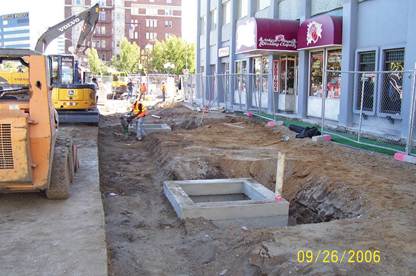

| Tree box filters |
|||
| Case studies | |||
Virginia Street Tree Box Filters
The design provides filtration of road runoff before it enters the storm drains and the Truckee River. These tree box filters have openings to the gutter called "curb cuts." First, the initial runoff flows from gutters into the boxes. Then the runoff is filtered by the soil and cleaned up (broken down by soil microbes and tree roots), and the water can be taken up by the tree. If the tree box fills up with water, an overflow drain inside the box allows overflow to enter the storm drain system and river. The result shows the following pollutant removal effectiveness: For more information and photos, visit: http://www.unce.unr.edu/programs/sites/nemo/lid/renotree/
University of New Hampshire Stormwater Center (UNHSC)
The UNHSC tree box filter system tested used a concrete vault filled with a bioretention soil mix. The vault is open bottomed to enhance infiltration. Results show that while the tree box filters were fairly successful in removing pollutants, they do not reduce peak flows unless sited in appropriate soils. For more information and details on rates of pollution removal and hydraulics, visit: |
|||
